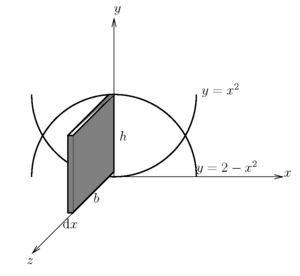Science:Math Exam Resources/Courses/MATH101/April 2011/Question 02 (b)/Solution 1
If we follow the hint, we can draw a diagram similar to the one pictured on the right
. We have drawn the axis so that we see the plane in its familiar 2D position.
The first thing we have to consider is the limits of where our picture begins and ends. To do this, we find the intersection points of our two parabolas. Therefore we want to find the such that
which occurs when . Notice from our diagram that is the left endpoint and is the right endpoint. As we are told in the question, the cross section in the -direction is a square which we can think of as a rectangular prism with a very small depth, . Therefore, the volume of any one square, , is given by
Since the cross section is indeed a square we have that and this equals the height between the two parabolas. Therefore,
and thus for any we have that the volume of the rectangle is,
To get the total volume we have to add up all the little square volumes that we would sweep out from the start of our figure at to the end at . However, there are an infinite number of values in this range and so what would normally be a sum, we write as an integral. Therefore,
Therefore, the volume of the solid is .















